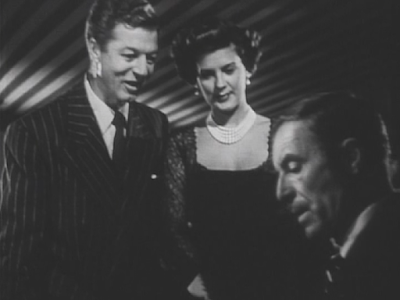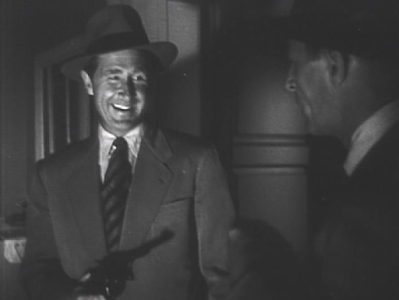I wasn’t enthusiastic about seeing Trapped. I had read that the film used the semidocumentary style and started with a voice-over narrator who explained what the U.S. Treasury is and how it works. Maybe such background information is necessary for the counterfeiting operation that is at the heart of the story, but I was afraid that the film was going to be a yawner.
It’s true that the film opens with voice-over narration about the Treasury Department. A lot has changed since 1949, and I could tell that the information was outdated. Many films noir are a step back in time, which I find to be a plus, especially if history is an interest. But not that many films noir give so much historical data. One example from the voice-over narration in Trapped is that the U.S. Treasury Department used to oversee the U.S. Coast Guard; today, the Coast Guard is part of the U.S. Department of Homeland Security. Yes, indeed, the opening is packed with information.
Once the voice-over narrator gives over to the fictional story, viewers learn still more. A restaurant proprietor, Mrs. Flaherty, wants to make a deposit to her bank account. The teller notices that one of the twenty dollar bills she plans to deposit is a counterfeit. She asks for the bill back, but the teller won’t return it. Mrs. Flaherty is out twenty dollars because it is her responsibility to check that all legal tender given to her is indeed legal. (This also applies to the foreign coins I often receive from gas station and grocery store transactions.)
The bank turns the counterfeit bill over to the Secret Service, whose agents recognize Tris Stewart’s brand of counterfeiting. He is in prison, but he didn’t have the plates for making the counterfeit bills when he was arrested, so someone else must be using the same plates to distribute counterfeit currency once again. Secret Service Agent Raymond visits Stewart in prison to start the investigation.
(This article about Trapped contains almost all the spoilers.)
Agent Raymond asks Stewart about his contacts on the outside. Stewart refuses to talk, even with the offer of reduced prison time. Several weeks later, however, Stewart is being transferred by bus to another prison in the custody of a U.S. deputy marshal. He grabs the marshal’s gun and forces him to take off the handcuffs that bind them together. Then he demands to be let off the bus. At first, it appears that a friend is waiting to pick him up, but viewers quickly learn once Stewart is in the car that the “friend” is Secret Service Agent Foreman.
While in the custody of Agent Foreman, Stewart makes phone calls to help locate the old counterfeiting plates. Before he can provide any useful information, Stewart fakes an accident with a broken glass to escape and meet his old girlfriend Meg Dixon. Viewers subsequently learn that this second escape has also been staged, but this time Tris Stewart doesn’t know anything about it.
Meg Dixon is working as a cigarette girl under the alias Laurie Fredericks at a nightclub in Los Angeles. She has caught the eye of someone named Johnny Hackett. Viewers learn before Dixon and Stewart do that Hackett is an undercover Secret Service agent. Dixon and Stewart also don’t realize at first that Dixon’s apartment is bugged. Agents learn from their conversation that Stewart’s ex-partner still has the counterfeiting plates and that Stewart wants to get them back and go to Mexico with Dixon.
Trapped has many plot twists, which was a welcome surprise to me. Only one plot twist bothered me a bit. An old army buddy blows Johnny Hackett’s cover in Chanteclair, the nightclub where Laurie Fredericks (Meg Dixon) works. The man’s name is Bill, and he is out for the night with his wife. He recognizes Johnny Hackett as John Downey from their wartime service in the U.S. army. Downey/Hackett denies knowing the man, and Bill’s wife Betty is the one who cuts short Bill’s insistence that he knows Downey. When Bill and his wife get to their table, he explains that when he knew Downey, he worked in military intelligence. Bill admits that the man is probably still working undercover, and he says all this within earshot of Meg Dixon.
I found this particular coincidence hard to believe because I wasn’t so sure that someone who knew Downey and knew something about military intelligence would be so insistent about the man’s identity or about knowing him, or would be so quick to explain everything to his wife while they were sitting in a crowded nightclub. This incident is an important plot point because Meg Dixon uses the information to warn her boyfriend Tris Stewart and his partner Jack Sylvester, but it seems to be based on a flimsy assumption about the behavior of former service members.
Eagle-Lion Films is one of the old Hollywood Poverty Row producers, so I wasn’t expecting star power or crisp production values. I’m not sure that Trapped even makes the grade of B movie. The action is sometimes obliterated by nearly complete darkness, which is certainly one way to save money and time.
But the film doesn’t skimp on violence. Meg Dixon is shot by Jack Sylvester, and when federal agents arrive on the scene, they step over her body to chase down Sylvester. Sylvester electrocutes himself trying to hide in a trolley yard. A couple of fight scenes between Tris Stewart and Secret Service agents are long and physical. I was surprised that one of them survived his head being beaten against an iron bedframe. In 1949, and in a Poverty Row production, there is (thankfully) no blood or other physical damage to witness.
Lloyd Bridges was fantastic, however, as Tris Stewart. He exudes menace, and he is completely believable when Stewart’s plans don’t go the way he had hoped and his character becomes increasingly desperate. I didn’t have high expectations for Trapped, and I must confess that I didn’t enjoy it as much as other noirs. At seventy-eight minutes, however, Trapped is worth a look, especially for fans of film noir and U.S. history.
October 1, 1949, release date • Directed by Richard Fleischer • Screenplay by Earl Felton, George Zuckerman • Based on a story by Earl Felton, George Zuckerman • Music by Sol Kaplan • Edited by Alfred DeGaetano • Cinematography by Guy Roe
Lloyd Bridges as Tris Stewart • Barbara Payton as Meg Dixon, alias Laurie Fredericks • John Hoyt as Agent John Downey, alias Johnny Hackett • James Todd as Jack Sylvester • Russ Conway as Chief Agent Gunby • Robert Karnes as Agent Fred Foreman • Douglas Spencer as Sam Hooker • William Woodson as the narrator
Distributed by Eagle-Lion Films • Produced by Bryan Foy Production, Contemporary Production




No comments:
Post a Comment